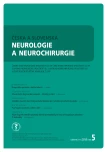Non ‑ organic Visual Loss in Children
Authors:
L. Vaculová 1; J. Timkovič 1–3; D. Cholevík 1,2; H. Medřická 4; K. Panáčková 4
Authors‘ workplace:
Oční klinika LF OU a FN Ostrava
1; Katedra kraniofaciálních oborů, LF OU v Ostravě
2; LF MU, Brno
3; Oddělení dětské neurologie, FN Ostrava
4
Published in:
Cesk Slov Neurol N 2015; 78/111(5): 562-567
Category:
Short Communication
doi:
https://doi.org/10.14735/amcsnn2015562
Overview
Purpose:
The objective of the present paper is a description of clinical findings in four children with non-organic visual loss (NOVL).
Methods:
A retrospective case series analysis was performed on four girls who were followed up at the Ophthalmology Department of the University Hospital Ostrava from 1st January 2014 to 31st December 2014. The mean age of these patients was 13 years (median 14 years, range 9–17 years). Ophthalmological and neurological examinations were performed, including brain MRI, visual evocated potentials, electroretinography as well as lumbar puncture in one case. All girls were examined by a children psychologist.
Results:
An organic cause of reduced visual acuity was not identified in any of the four cases. The results of ophthalmological, neurological and other examinations (VEP, ERG, MRI, lumbar puncture) were negative. Psychological examination confirmed predominant psychosomatic background of the disorder in all cases. Visual acuity resolved completely in all patients after three psychotherapy sessions led by a child psychologist.
Conclusion:
Non-organic visual loss is a clinical diagnosis of inexplicable monocular or binocular visual acuity impairment without any organic eye disorder or general disease. Diagnostic process is lengthy and requires cooperation of various medical specialities. Psychotherapy is the primary therapeutic approach and should be supervised by an experienced child psychologist.
Key words:
non-organic visual loss – psychogenic vision disorders – childhood
The authors declare they have no potential conflicts of interest concerning drugs, products, or services used in the study.
The Editorial Board declares that the manuscript met the ICMJE “uniform requirements” for biomedical papers.
Sources
1. Beatty S. Non ‑ organic visual loss. Postgrad Med J 1999; 75(882): 201 – 207.
2. Beau BB, Newman NJ. Functional visual loss. Neurol Clin 2010; 28(3): 789 – 802. doi: 10.1016/ j.ncl.2010.03.012.
3. Catalano RA, Simon JW, Krohel GB, Rosenberg PN. Functional visual loss in children. Ophthalmology 1986; 93(3): 385 – 389.
4. Kinori M, Wygnanski ‑ Jaffe T, Huna ‑ Baron R. Functional visual loss in an Israeli pediatric population. Isr Med Assoc J 2011; 13(11): 684 – 688.
5. Munoz ‑ Hernández AM, García ‑ Catalán R, Santos ‑ Bueso E, López ‑ Abad C, Gil ‑ De ‑ Bernabé JG, Díaz ‑ Valle D et al. Simulation in ophthalmology. Arch Soc Esp Oftalmol 2011; 86 : 320 – 326.
6. Toldo I, Pinello L, Suppiej A, Ermani M, Cermakova I, Zanin E et al. Nonorganic (psychogenic) visual loss in children: a retrospective series. J Neuroophthalmol 2010; 30(1): 26 – 30. doi: 10.1097/ WNO.0b013e3181c252b9.
7. Masahiro O, Harasawa K, Hiroko S, Masahiko U, Hoshika A. The characteristics of static visual fields in children with psychogenic visual disturbances. Jpn J Ophthalmol 2000; 44(5): 516 – 519.
8. Shindler KS, Galetta SL, Volpe NJ. Functional visual loss. Curr Treat Options Neurol 2004; 6(1): 67 – 73.
9. Taich A, Crowe S, Kosmorsky GS, Traboulsi EI. Prevalence of psychosocial disturbances in children with non-organic visual loss. J AAPOS 2004; 8(5): 457 – 461.
10. Thompson HS. Functional visual loss. Am J Ophthalmol 1985; 100(1): 209 – 213.
11. Yoneda T, Fukuda K, Nishimura M, Fukushima A. A case of functional (psychogenic) monocular hemianopia analyzed by measurement of hemifield visual evoked potentials. Case Rep Ophthalmol 2013; 4(3): 283 – 286. doi: 10.1159/ 000357279.
12. Bain KE, Beatty S, Lloyd C. Non ‑ organic visual loss in children. Eye 2000; 14(5): 770 – 772.
13. Corboz RJ, Felder W. Psychosomatische wechselbeziehungen in der pädiatrischen ophthalmologie. Klin Mobl Augenheil 1982; 181(4): 266 – 269.
14. Kathol RG, Cox TA, Corbett JJ, Thompson HS. Functional visual loss: follow‑up of 42 cases. Arch Ophthalmol 1983; 101(5): 729 – 735.
15. Costenbader FD, Mousel DK. Functional amblyopia in early adolescence. Clin Proc Child Hosp 1964; 20 : 49 – 58.
16. Otradovec J. Vyšetření zrakových funkcí. In: Otradovec J (ed.). Klinická neurooftalmologie. 1. vyd. Grada 2003 : 61.
17. Wilson JE. Hysterical amblyopia. Am J Ophthalmol 1948; 31(12): 1635.
18. Curran KE. Ocular hysteria. Postgrad Med 1966; 40(4): 455 – 458.
19. Rada RT, Krill AE, Meyer CG. Visual conversion reaction in children and adults. J Nerv Ment Dis 1978; 166(8): 580 – 587.
20. Greenleaf E. The red house: hypnotherapy of hysterical blindness. Am J Clin Hypnosis 1971; 13 : 155 – 161.
21. Wilkins LG, Field PB. Helpless under atack: hypnotic abreaction in hysterici loss of vision. Am J Clin Hypnosis 1968; 10 : 271 – 275.
22. Yasuna ER. Hysterical amblyopia in children. Am J Dis Child 1963; 106 : 558 – 563.
23. Donin JF. The ophthalmic flake syndrome. In: Smith JL (ed.). Neuroophthalmology. New York: Masson 1981 : 89 – 98.
Labels
Paediatric neurology Neurosurgery NeurologyArticle was published in
Czech and Slovak Neurology and Neurosurgery

2015 Issue 5
Most read in this issue
- Diagnostic in Patient with Acute Vertigo
- Recurrent Transient Global Amnesia – Four Case Reports
- Normative Data for the Rey‑ Osterrieth Complex Figure Test in Older Czech Adults
- Contribution of Olfactory Tests to Diagnosis of Neurodegenerative Diseases
